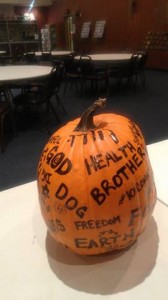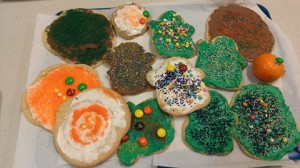Halloween. All Hallow’s Eve. All Saints Day. All Souls Day. I have Jewish friends who don’t celebrate Halloween because it is Christian. I have Christian friends who don’t celebrate because it is pagan. I am a rabbi. What to do? Do we cancel Hebrew School because we know the kids aren’t going to show up or do we hold it any way in some kind of defiance? Do we carve pumpkins? Go trick or treating? Pass out candy? Have a party?
Here is my answer. While Halloween has its pagan, wiccan roots and its Christian overlay, it has become a fun holiday that kids (and adults) look forward to. The Talmud says at the end of some thorny arguments, “Puk Hazei Mai Amma Davar – go see what the people are doing” (Berachot 45a, Eruvin 14b). The people are celebrating Halloween. That much is clear. Why?
Partly because it is fun. Partly because it falls (pun intended) during a dark part of the year and we need a little joy. Partly because many people have a fascination with the world beyond. Just look at the growing industry around Zombies.
So what how can Jews mark Halloween in a meaningful way, if not religiously?
We can use this time to join with the secular community for fun. The students in my Chai School (post Bnei Mitzvah) hosted a party at the Community Crisis Center for children and parents who might not have had any Halloween fun. They carved pumpkins, frosted Halloween cookies and painted faces. Nothing scary, mostly cats.
We can use this time to teach about our own traditions around death and dying. What does Judaism say about life after death (Trick question. No one answer)? What is a golem? A dybbuk? Do we believe in resurrection? Reincarnation? Why do we say Kaddish for a parent for 11 months and not 12? Is there purgatory? What does it mean that we live on in the memories of those we touch?
We can retell the story of the Rabbi and the 29 witches. Maybe that is where Baum got some of his ideas for the Wizard of Oz. Marilyn Hirsch wrote this up as a delightful children’s book which was reprinted recently as a PJ Library book. The gist of the story, from the Talmud no less: Rabbi Simon ben Shetach knew of a cave with 80 old women or maybe 29 just wasting away. Nonetheless they were scaring the townspeople. They would not come out of the cave because they were afraid of the rain. (Cue music here, “I’m melting, I’m melting”?) One day when the rain was coming down especially hard (like maybe tonight?!) the rabbi gathered 80 eighty tall, young men. Each man received a new tallit (prayer shawl) and a pitcher. They put the prayer shawls in the pitchers to keep them dry. Rabbi Shimon gave the men instructions. “When we arrive at the cave, when I whistle once put on your prayer shawls. When I whistle again, come into the cave and pick up a witch in your arms. (Apparently when witches are off the floor they lose their power!). When they reached the cave, Rabbi Shimon knocked. The head witch noticed that he was dry despite the rain. “I walked between the raindrops,” the rabbi answered. Four witches performed magic tricks for the rabbi. Witches are very good at magic. Then the head witch said, “What can you do?” He answered that he could whistle and 80 men would appear to entertain them. He whistled and 80 men appeared with their dry prayer shawls, and danced with the witches, right out of the cave and into the rain. The witches were not a problem again. The PJ Library reader’s guide makes this charming story to be about social action and tikkun olam. The rabbi had courage to take on a problem and solve it. How can we?
Witches have a storied history in our culture. The Bible says “Suffer a witch not to live.” In truth, Judaism never put someone to death for being a witch. That happened in Salem, MA. More out of fear than anything else. (I could and have written pages on that topic!). Judaism does teach that we should treat the widow, the orphan and the stranger with kindness. Those people who are the most marginalized among us. 36 times this refrain is repeated. So if there are people we are afraid of, like the witches in the rabbi and the 29 witches, maybe the rabbi had the right idea. Instead of shunning them, we should welcome them into the community. Maybe that is what Halloween is about.
Halloween has many similar features to the Jewish holiday of Purim. At Halloween we collect treats. At Purim we give treats. One thing some youth groups have done is to collect canned goods for a food pantry. Or some kids still collect pennies for UNICEF.
Children get to choose costumes. Act out who they would like to be. It could be a witch or a vampire or a zombie. It could be a ballerina, a princess, a fairy, a cheerleader, a super hero, a football player, a fireman. Talk to your child about who they want to be. One year, when Sarah’s third grade class did biography day for Halloween she was Anne Frank among a lot of Michelle Kwans. Her choice. Really. This is not that different from a Jewish custom at Sukkot of inviting the Ushpizin, guests. Abraham and Sarah, Isaac and Rebecca, Jacob, Rachel and Leah, etc. Eight nights of guests. If you could invite anyone to dinner, past of present, who would you invite? Sukkot is the Jewish harvest festival, also at this time of the year. This year, based on something we say on Interfaithfamily.com, our students decorated a pumpkin with things we are thankful for. We will keep this pumpkin until Thanksgivingkuh. We will also use it to make a Giant Book of Blessings.
Rabbi Everett Gendler has always had a service Halloween Weekend that he calls Ya’akov Lantern. You know, Jack’s Hebrew name. Because we should light a candle against the darkness. It is a beautiful service with young and old bringing their carefully carved pumpkins, often with Jewish stars, to shul. The sanctuary glows with light.
My mother’s favorite holiday was Halloween. Just because it was fun. Some thought she was a witch and she could play that role. She lived in a black house. Wore black clothes. Collected kitchen witches. Twice she almost died on Halloween. Once she had lung surgery on Halloween. Her last year she was in the hospital planning costumes with red jello as blood and hospital gowns. Giggling like a teenager. She was happy, looking forward to my planned visit from Boston the next day. Then she had a heart attack. They revived her so the family could gather but some believe she really died on that table. I flew to Grand Rapids in my pumpkin shirt.
Tonight I will be passing out candy, making a bubbling caldron of chili to share with friends and remembering my mother, who taught that every day was a holiday so we should celebrate. Life is short, we learned from her as well. And we have much to be grateful for.
So have fun tonight. Light a candle or a pumpkin. Dance between the raindrops. Eat some candy but not too much. Share with others. Remember those who came before. Become, at least for a night, the person you want most to be.


Margaret, I loved your comments concerning Halloween! The story of the Rabbi and the 29 witches was charming. If I could invite anyone to dinner, past or present, it would be you and Karen, Jesus and the 12 disciples. I would have a long list of questions!
Your mother and Halloween was very touching. “Become, at least for a night, the person you want most to be.” My question has become “Who do I wish I had become?” My costume would have to be clerical robes.
You definitely have a ministry to many people who are not Jews by birth. You have already done so much to open the way to interfaith activities. I admire you greatly!
Recently I’ve been thinking about how to live my life so I enjoy the present. Until now I’ve not made the most of the present, and I want to change that. I don’t want to wish I’d done just because I was unsure or afraid.
You’ve made me revel in the fact that I knew your mother. Well, I only met her once, but the more I learn about her, the more I like and admire her and wish I’d known her much better.
You’re my friend, my support, my counselor, and from now on I’m going to like Halloween.
Hachayyim tovim!